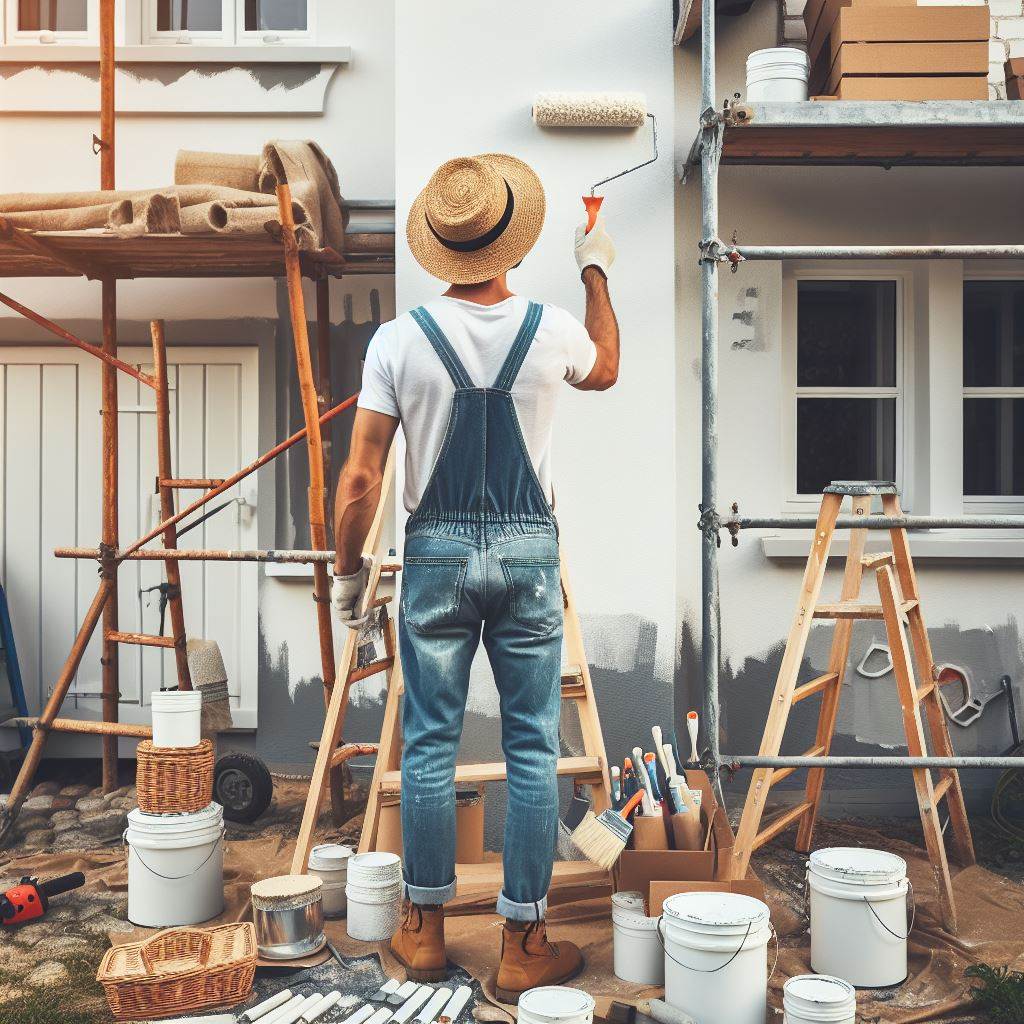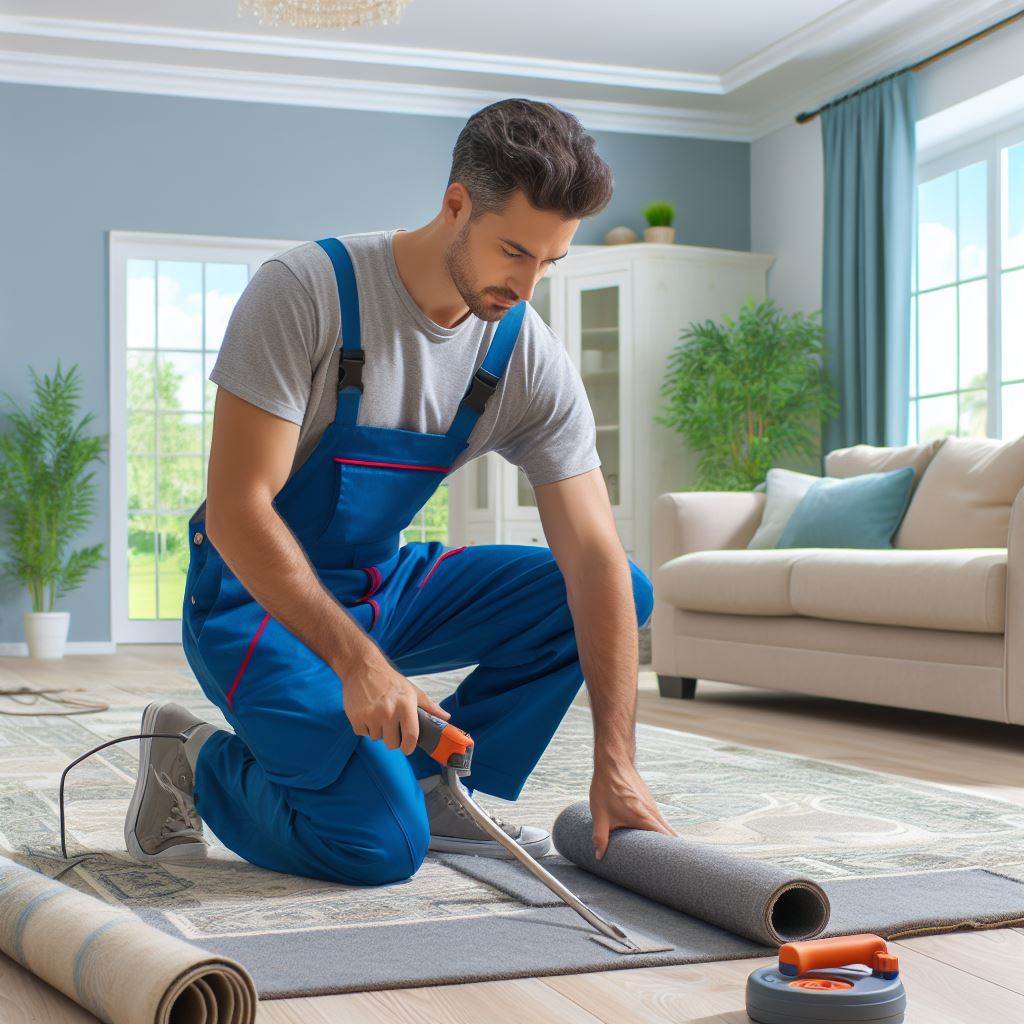Introduction
Painting and aesthetics play a crucial role in the real estate industry. A well-maintained and visually appealing property attracts potential buyers and renters.
Regular maintenance and painting are essential in preserving the property’s appeal.
Appearance greatly affects a property’s value and desirability.
When potential buyers or renters visit a property, they form an immediate impression based on the aesthetics.
A fresh coat of paint can instantly enhance its attractiveness.
Regular maintenance and painting are necessary to ensure that a property maintains its appeal over time.
Paint can fade, crack, or become dirty due to exposure to sunlight, extreme weather conditions, and general wear and tear.
By regularly inspecting and maintaining the paint, property owners can address any issues promptly.
This includes touch-ups, repainting, or even changing colors to keep up with current trends.
Moreover, regular painting and maintenance protect the property’s structure. Paint acts as a protective barrier against moisture, preventing rot and decay.
It also helps minimize the effects of environmental damage, such as mold and mildew.
Overall, the significance of regular maintenance and painting cannot be overstated in the real estate industry.
It not only enhances a property’s visual appeal but also protects its value and extends its lifespan.
In the following sections, we will explore various aspects of painting and aesthetics maintenance, including techniques, color choices, and cost-effective solutions.
Stay tuned for valuable insights on maintaining property appeal through painting and aesthetics.
The Role of Colors in Property Appearance
Introduction to color psychology in real estate
Colors play a crucial role in creating a desirable aesthetic appeal for properties.
Color psychology, a study of how colors influence human behavior and emotions, is relevant in real estate.
Understanding color psychology can help property owners make informed decisions to create visually appealing spaces.
How colors can influence buyer perception
Colors evoke specific emotions and associations, influencing buyer perception and decision-making.
Warm colors like red and orange can create a sense of urgency and excitement, suitable for attracting buyers.
Cool colors such as blue and green can convey tranquility and relaxation, making them appropriate for bedrooms and common areas.
Neutral colors like beige and gray provide a clean canvas, allowing buyers to envision their personal style in a space.
Impact of different colors on various types of spaces
- Living rooms benefit from warm and inviting colors that promote social interaction and comfort.
- Kitchens can be enhanced with vibrant and energetic colors that stimulate appetite and creativity.
- Bedrooms should have calming colors to promote relaxation and a peaceful atmosphere for rest.
- Bathrooms can benefit from bright and clean colors, creating a sense of hygiene and freshness.
- Home offices can be enhanced with colors that boost productivity, focus, and creativity.
- Exterior colors should complement the surrounding environment and architectural style, appealing to potential buyers.
Considering the impact of colors on buyer perception is essential when maintaining the appeal of a property.
By strategically using colors, property owners can create a positive and captivating ambiance that attracts potential buyers.
Read: Appliance Maintenance: Extending Lifespan & Safety
Benefits of Regular Painting and Maintenance
A well-maintained exterior is essential for any property as it contributes to its overall appeal and longevity.
Regular painting and maintenance can offer numerous benefits:
Enhancing curb appeal and first impressions
- Regular painting helps create an inviting and aesthetically pleasing atmosphere.
- Freshly painted exteriors can attract potential buyers and make a positive first impression.
- It gives a sense of pride to homeowners and portrays professionalism for commercial properties.
- A well-maintained property stands out in the neighborhood and adds to its overall visual appeal.
Extending the lifespan of the property
- Paint serves as a protective layer against the elements, preventing damage from UV rays, moisture, and temperature changes.
- Regular maintenance, such as sealing and repainting, helps prevent deterioration and extends the life of the property.
- By addressing issues promptly, you can avoid structural damage and save on costly repairs in the long run.
- Properly maintained surfaces have increased resistance to wear and tear, preserving the property’s overall integrity.
Preventing further damage and costly repairs
- Regular inspections can identify early signs of damage, such as cracks, peeling paint, or wood rot.
- Timely intervention can prevent issues from worsening and spreading to other areas of the property.
- Addressing minor problems promptly saves you from more significant damages and expensive repairs.
- By keeping up with maintenance, you can detect and fix underlying issues before they become major concerns.
Increasing property value and marketability
- Painting the exterior regularly gives the property a well-maintained appearance, increasing its market value.
- Buyers are often willing to pay more for a property that requires minimal work and looks visually pleasing.
- A well-painted property stands out among competitors, attracting more potential buyers or tenants.
- Investing in regular maintenance showcases your commitment to the property and instills buyer confidence.
In fact, regular painting and maintenance offer multiple benefits, including improved curb appeal, extended property lifespan, prevention of further damage, and increased value and marketability.
By investing in these practices, property owners can ensure their properties remain visually appealing, structurally sound, and economically beneficial in the long term.
Read: Cloud Computing in Property Management
Choosing the Right Paint Colors
Factors to consider when selecting paint colors
When choosing the right paint colors for a property, there are several factors to consider. Room size and natural light play a crucial role in how colors will appear.
For smaller rooms with limited light, lighter colors can help create the illusion of space.
In contrast, larger rooms with ample natural light can handle darker and bolder colors.
The mood you want to create in each space should also be considered.
For example, calming and soothing colors like blues and greens are great for bedrooms and bathrooms, while warm and energetic colors like yellows and oranges are more suitable for living areas and kitchens.
The function of each room should also influence your color choices.
A home office may benefit from cooler colors that promote focus and concentration, while a dining room may benefit from warm and inviting colors that encourage conversation and enjoyment.
In addition to the function of each room, the existing furniture and decor in the space should be taken into consideration.
You want the paint colors to complement the existing elements and create a cohesive look.
If you have colorful furniture, you may want to opt for neutral wall colors to let the furniture stand out.
On the other hand, if your furniture is more neutral, you can consider using bolder colors on the walls to add interest.
Considering the overall color scheme and flow throughout the property is essential for a harmonious look.
Different rooms should have a cohesive color palette that ties them together, creating a sense of continuity.
This does not mean that all rooms need to be painted the same color, but rather that they should complement each other.
It is also important to consider the psychology of colors. Different colors evoke different emotions and can affect mood and perception.
Soft blues and greens can create a calming and peaceful atmosphere, while reds and oranges can stimulate appetite and energy.
Understanding the psychological impact of colors can help you create the desired ambiance in each room.
Tips for choosing colors that complement the property’s architecture
When selecting paint colors that complement the property’s architecture, it is crucial to take the architectural style into account.
Traditional architecture often looks best with classic colors like whites, creams, and earth tones.
These colors highlight the architectural details and create a timeless look.
In contrast, contemporary architecture can handle bolder and vibrant colors, as well as sleek neutrals.
These colors can enhance the modern and minimalist aesthetic of the property.
Matching the color palette to the architectural style creates a harmonious look that showcases the best features of the property.
Accents and trim colors should also be considered when choosing paint colors. These colors can highlight architectural details and add visual interest.
Choosing complementary colors to the main wall color can create a more dynamic and visually pleasing space.
The surrounding environment and landscape can also provide inspiration for paint colors.
Taking cues from the natural surroundings can help create a sense of harmony and connection to the outside.
For example, if the property is located in a lush green area, incorporating shades of green into the interior can bring the outside in and create a cohesive look.
Importance of considering target demographic and market trends
Lastly, considering the target demographic and market trends is essential when selecting paint colors.
Understanding the preferences of the potential buyers and staying updated with the industry trends can increase the property’s appeal and value.
Certain color palettes may resonate more with specific demographics, and using trendy colors can make the property feel modern and up-to-date.
In short, choosing the right paint colors is crucial for maintaining the appeal of a property.
Factors such as room size, natural light, function of each room, existing furniture and decor, overall color scheme, architectural style, and target demographic should all be considered.
By carefully selecting colors that complement these factors, you can create a visually appealing and harmonious space that appeals to potential buyers.
Read: HVAC Maintenance: Keeping Tenants Happy & Healthy

Necessary Steps for Proper Painting and Maintenance
Preparing the surfaces for painting
- Clean the surfaces thoroughly to remove any dirt, dust, or grease.
- Repair any cracks, holes, or imperfections in the walls using spackling paste or filler.
- Sand the surfaces to create a smooth and even base for the paint.
- Apply a primer to seal the surface and enhance paint adhesion.
Selecting high-quality paints and materials
- Choose paints that are specifically designed for the surface you are painting.
- Opt for high-quality brands that offer durability and a wide range of colors.
- Invest in quality brushes, rollers, and other painting tools for better application.
- Consider using eco-friendly paints or low VOC options for a healthier environment.
Techniques for achieving professional-looking results
- Use proper brush strokes or roller techniques to achieve an even and smooth finish.
- Apply paint in thin and even coats, allowing each coat to dry before applying the next.
- Pay attention to the direction of natural light to avoid shadows or uneven coloring.
- Use painter’s tape or masking tape to create clean lines and protect adjacent surfaces.
The importance of proper drying time and post-painting clean-up
- Follow the manufacturer’s instructions for drying time between coats and overall drying time.
- Avoid touching or moving the painted surfaces until they are completely dry.
- Properly dispose of paint cans, brushes, and other materials according to local regulations.
- Clean brushes, rollers, and other painting tools immediately after use to prolong their lifespan.
- Wipe off any spills or splatters immediately to prevent them from drying and becoming harder to remove.
Taking the necessary steps for proper painting and maintenance is crucial in achieving appealing and long-lasting results.
By preparing the surfaces adequately, selecting high-quality paints and materials, using appropriate techniques, and allowing sufficient drying time, you can transform any space into a masterpiece.
Additionally, post-painting clean-up ensures the longevity of your tools and a clean, polished finish.
Remember, painting is not just about adding color to a surface; it is an art that requires attention to detail and proper maintenance to preserve its aesthetic appeal.
Read: Roof and Gutter Care: Tips for Property Longevity
Addressing Common Painting Challenges
Dealing with peeling or flaking paint
- Inspect the area and identify the cause of peeling or flaking paint.
- Scrape off loose paint using a scraper or putty knife.
- Sand the surface to ensure a smooth and even texture.
- Prime the area with a high-quality primer before applying new paint.
- Choose a paint that is specifically designed for the surface you are painting.
- Apply two coats of paint, allowing sufficient drying time in between.
- Maintain the painted surface regularly to prevent future peeling or flaking.
Removing stains or discoloration
- Identify the type of stain or discoloration on the painted surface.
- Choose an appropriate cleaning solution based on the stain’s nature.
- Gently scrub the stained area using a soft cloth or sponge.
- Rinse the surface thoroughly with clean water to remove any residue.
- If the stain persists, consider using a mild chemical cleaner or paint thinner.
- Repaint the affected area if necessary, using a matching color and finish.
Strategies for covering previous dark or bold color choices
- Start by cleaning the surface to remove dirt and debris.
- Use a high-quality primer with excellent coverage to neutralize the previous color.
- Apply multiple coats of primer if the previous color is particularly dark or bold.
- Choose a new paint color that complements your desired aesthetic.
- Use multiple coats of paint, allowing each coat to dry completely.
- Consider using a paint with built-in primer to ensure better coverage.
Handling exterior painting challenges such as weather conditions and surface preparation
- Check the weather forecast and choose a suitable time for painting.
- Avoid painting in extreme temperatures or when rain is expected.
- Prepare the surface by cleaning it thoroughly and removing any loose paint.
- Repair any cracks or damaged areas before painting.
- Use high-quality exterior paint that is specifically formulated for durability.
- Apply the paint using the appropriate tools, such as brushes or rollers.
- Allow sufficient drying time between coats and protect the painted surface from the elements.
- Regularly inspect and maintain the exterior paint to ensure its longevity.
DIY vs. Professional Painting Services
Benefits of hiring professional painters
- Quality results guaranteed with professional painters due to their expertise and experience.
- Save time and effort by hiring professionals who can efficiently complete the painting project.
- Well-equipped with the right tools and materials, ensuring a smooth and flawless finish.
- Professional painters can offer expert advice on color selection and complementary shades for appealing aesthetics.
- Insurance coverage provided by professional painting services protects against any potential damage or accidents.
- Professional painters can handle challenging surfaces, such as ceilings or high walls, with ease and safety.
Cost considerations and budget-friendly alternatives
- Professional painting services may seem expensive initially, but they provide value for money in terms of quality.
- Compare prices, gather quotes, and negotiate with different professional painting services for cost-effectiveness.
- Consider the long-term benefits of professional painting, such as durability and fewer maintenance requirements.
- For budget-friendly alternatives, consider purchasing high-quality paint and tools to achieve better results.
- Research and learn different techniques to achieve appealing aesthetics while painting on your own.
Tips for successful DIY painting projects
- Prepare the surfaces properly by cleaning, sanding, and priming them before painting.
- Protect areas not intended for painting by using painter’s tape and drop cloths.
- Use high-quality brushes, rollers, and paint to ensure a professional-looking finish.
- Apply paint evenly and smoothly using proper techniques such as feathering and blending.
- Allow sufficient drying time between coats for a better finish and avoid paint drips.
- Clean up your painting tools properly to maintain their longevity.
Understanding the limitations and when professional help may be necessary
- Complex painting techniques such as faux finishes or intricate designs may require professional expertise.
- Painting large areas or surfaces that are difficult to access may be more efficiently done by professionals.
- Consider your own skill level and the time and effort required before deciding to tackle a painting project on your own.
- If the painting project involves hazardous materials or requires specialized equipment, professional help is advisable.
- When in doubt, consulting with professional painters can provide guidance and clarity on the best course of action.
By weighing the benefits and cost considerations, you can make an informed decision between DIY painting and hiring professional services.
Remember, regardless of the choice, the goal is to maintain the appeal of your painted surfaces and enhance the aesthetics of your space.
Conclusion
The importance of painting and aesthetics for property maintenance cannot be understated.
A well-maintained and visually appealing property not only enhances its overall look but also increases its value in the market.
Regular upkeep and professional painting services play a crucial role in maintaining the appeal of a property.
By investing in regular maintenance, property owners can ensure that their property remains attractive and visually pleasing to potential buyers or tenants.
It is essential to prioritize regular painting and maintenance activities to prevent issues like paint deterioration, discoloration, or peeling.
Such problems can result in a negative perception of the property, decreasing its desirability and value.
The look and feel of a property have a significant impact on its overall appeal.
A well-maintained and aesthetically pleasing property creates a positive impression on visitors, potential buyers, or tenants.
Furthermore, a visually attractive property stands out among other properties in the area, increasing its market value and potential for higher rental or sale prices.
Property owners should recognize the importance of painting and aesthetics in maintaining the appeal and value of their properties.
Regular upkeep and professional painting services are essential investments that contribute to the overall attractiveness and desirability of a property.
By prioritizing maintenance and keeping the property visually appealing, owners can enjoy increased market value and attract potential buyers or tenants more effectively.




